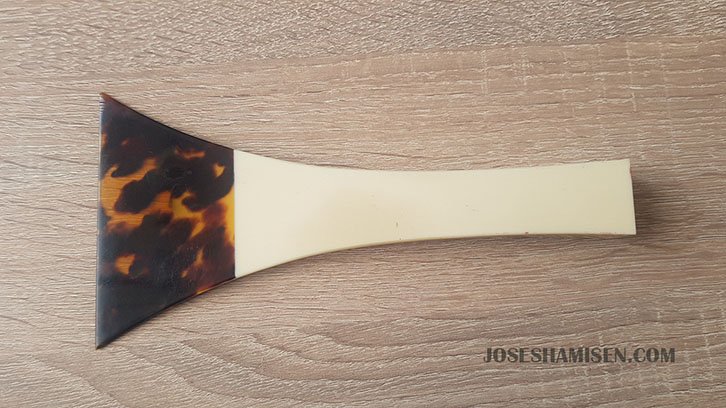This week’s post is the second part of Secrets of the Nagauta Shamisen. If you haven’t read that article yet, I recommend you do so before starting this one.
The first time someone sees a person playing the shamisen, one of the things that catches their attention is the contraption they use to strum the strings and make it sound. This object in question is known as a Bachi and today I will tell you in depth about its characteristics.

This plectrum has a very particular appearance. It can vary in size and thickness but the typical shape is always the same, narrow at the base and wide at the tip. We can say that a bachi consists of two parts: the handle and the blade.
The handle of a bachi is usually made of plastic or ivory, while the blade is made of Bekkô (turtle shell). There are bachis made of only one material, but they are usually made of Bekkô for the blade and ivory or plastic for the handle.
Below you can see some examples of their different types and characteristics:
Wooden Bachi
It is used in both Nagauta and Tsugaru styles. It is a bachi usually used by beginners. Not very flexible but with good grip.

Plastic Bachi
Used in both Nagauta and Tsugaru style. Also used by beginners, high hardness but with a brighter sound.

with Bekkô tips
It is only used in Nagauta style. It is a quality bachi, constructed with plastic handle and tortoise shell tips. It has a greater flexibility and a more balanced tone than the previous ones.

Ivory Bachi
Used only in Nagauta style. High hardness, with a point of flexibility and a cleaner, crisper tone. Practically extinct today.

We could say that these are the most common types of bachi, being the bachi with a Bekkô blade the jewel in the crown. The latter, being a very expensive plectrum, is usually made to measure.
There are musicians who prefer them with a thinner blade, in my case, I prefer them with a wide and thick blade, about 12cm wide and about 2mm thick. With these characteristics a more powerful and resonant sound is achieved. Of course, being thicker, it is more difficult to use and also more expensive.
This type of plectrum can cost between 400 and 2000 euros, yes, what you read, they are extremely expensive. The price varies according to the quality of the tortoise shell, this is indicated by its grain and clarity. The higher the clarity, the greater the flexibility and usually the higher the price.
Nowadays there are alternatives with semi-flexible resin materials, but, in my case, I’m still not completely convinced by their sound, so I usually go for the Bekkô ones.

Finally, you may be wondering how the hell do you grab a bachi? Well, here’s the answer. A really strange hand position, but one that is surprisingly easier to assimilate and put into practice than it seems.

I hope you found this article interesting, if so, please share it via the links below.
See you next week!
Jose